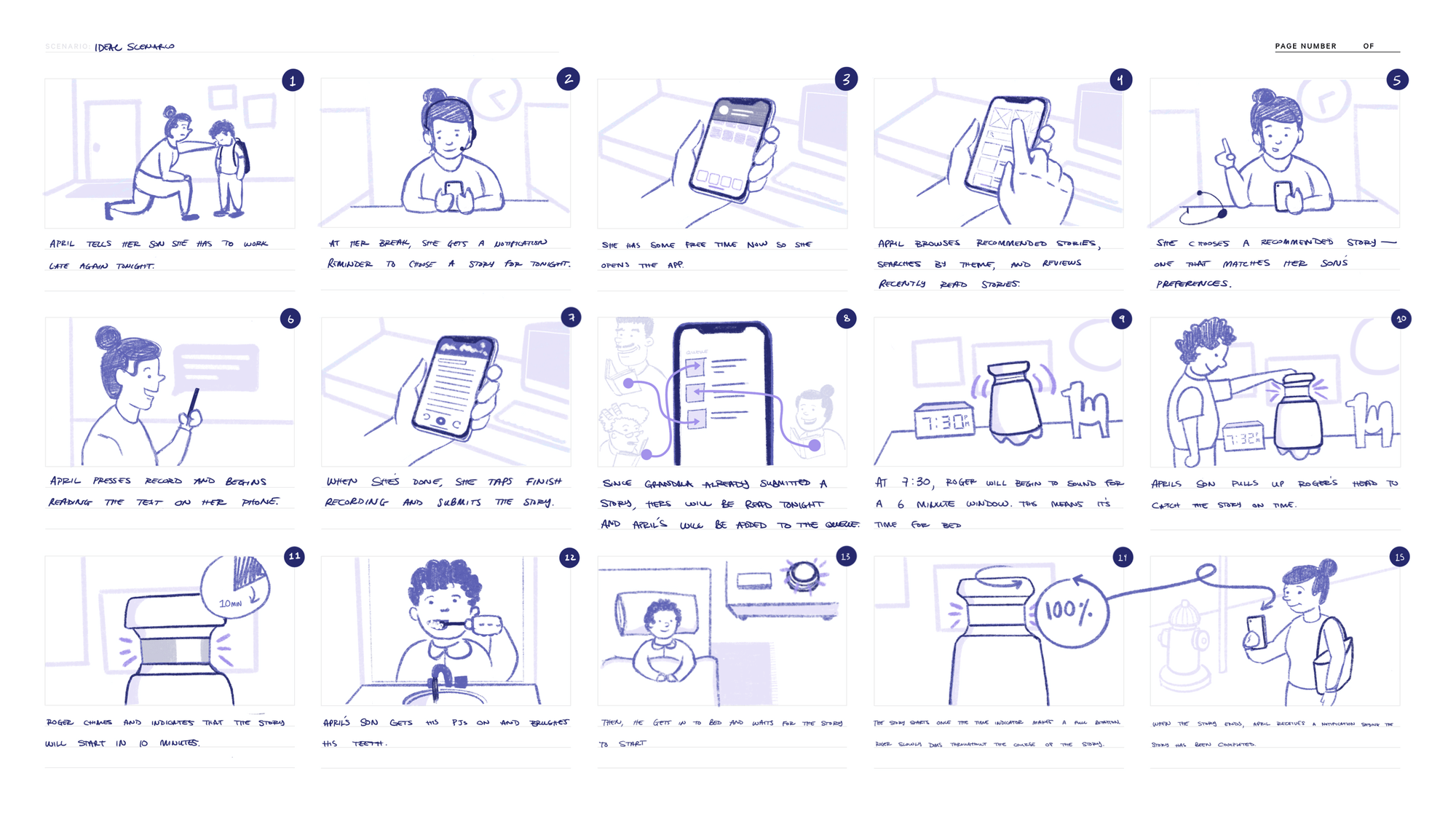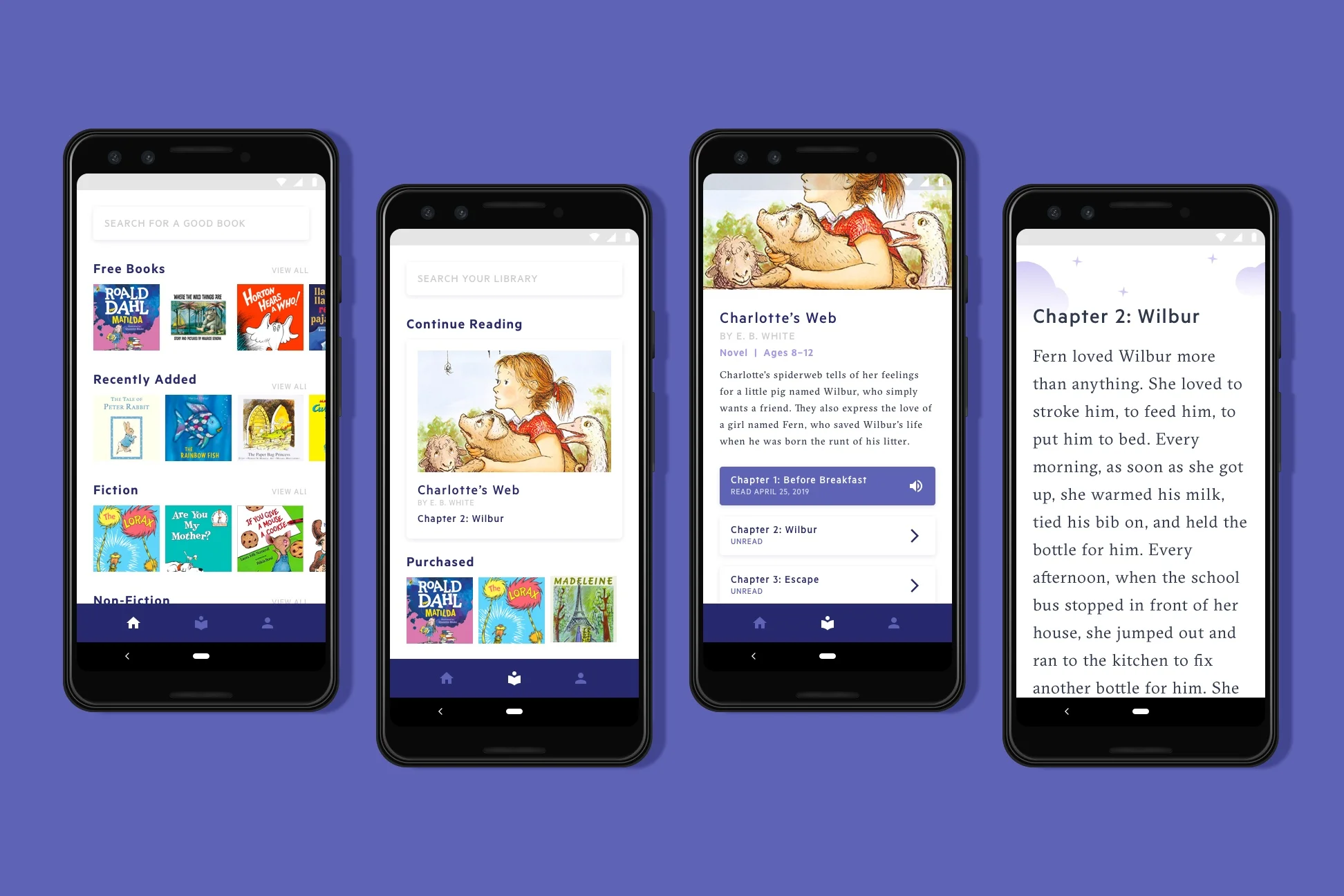Roger: A Bedtime Story Platform for Consistent Sleep Schedules
Roger is a device that helps children of low-income families get consistent sleep. Designed for the many children whose parents work irregular hours, it aims to get children to bed on time, especially when parents are not available. Created by recent graduate Kevin Cook as part of his thesis, Closer Kin: Building Stronger Family Environments, Roger releases a pre-recorded bedtime story every night at a specified time and gives children an incentive to get to bed on their own. Roger won a silver 2019 European Product Design Award (EPDA) in the Illumination/Interactive Lighting Projects category.
Kevin set out to design a structured bedtime ritual for children with parents who need to work during bedtime. Ultimately, the goal of Roger is to create consistency and predictability in children’s daily routines—an outcome that relieves parental stress and improves children’s health, behavior, and cognitive development. Research shows that inconsistent sleep is detrimental to children’s development, contributing to disparities in health, school, and behavioral outcomes. 30% of American parents with children aged 4-10 have to work non-standard shifts (during the time their children go to bed), and it is not surprising that these parents often have trouble implementing a rigid bedtime routine in their absence.
Roger addresses these sleep inhibiting factors unique to low-income families. First, Roger addresses the lack of structure commonly found in low-income homes by introducing a cue for bedtime. The excitement of hearing a familiar voice, coupled with the urgency not to miss a story, gives children an incentive to get to bed at a reasonable time on their own. This ritual creates a predictable bedtime routine that is essential for healthy circadian rhythms. Second, the sound of hearing a trusted voice combats pre-sleep worries by making children feel safe. Since regular closeness increases the opportunity for parents to be emotionally available, it strengthens the relationship between parent and child. This availability gives children the comfort they need to fall asleep faster and sleep more soundly at night. By addressing the issues unique to low socioeconomic status families, Roger aims to improve children’s sleep as a strategy to improve health, behavior, and cognitive development.
Here is how it works: Parents record stories on their mobile app and upload new content to Roger’s queue. At bedtime, children can listen to the stories by interacting with the product. Kevin explains the steps, "When it is time for bed, Roger will calmly sound for a 6-minute window. Lift Roger’s head to tune in to the story. A light indicates how much time is left until the story starts, giving children a few extra minutes to get ready for bed. When the light makes a full rotation, the story begins with a pavlovian chime and ritual anecdote about bedtime. Throughout the story—about 12 minutes, the light slowly dims. When the story concludes, Roger wishes the child goodnight and notifies their parents they have gone to bed."
The nightlight indicates how much time is left until the story begins.
Defining the User
To understand whom he was designing for, Kevin conducted 12 initial phone interviews with low-income single parents with annual incomes less than $30,000. “To understand behaviors, I asked parents questions about their work schedules and evenings. What time did their kids go to bed? Did they have a bedtime routine? What did they do when their kids refused to go to sleep? To understand their attitudes, I asked questions about how they felt during these times, how they defined their goals and what their challenges were. Finally, I asked parents how they would describe both the perfect evening as well as the disaster scenario. This gave me insight into the non-obvious ways I could satisfy their needs.”
After scanning his interview notes, Kevin created empathy maps to code his findings into a standardized format. He categorized findings and detailed what each user said, thinks, does, and feels. He looked for themes that emerged across maps and aggregated his findings in the form of a persona. “Although fictional, this persona allowed me to visualize the target users’ attitudes and goals and would serve as a guidepost for my designs. To understand how the product works in context, I sketched a storyboard of the ideal sequence my fictional user would follow when using the product. The storyboard allowed me to visualize touchpoints between the user and the product, along with the emotions they felt at each stage.”
Kevin designed the experience by creating user flows and wireframes to capture the application’s primary task of recording a story. Kevin also considered edge scenarios and designed a prioritization system for the content queue. If no new content is uploaded before the daily deadline, Roger defaults to the daily cast. Likewise, if multiple recordings are uploaded, the earlier content takes priority.
User flow shows necessary steps to record a bedtime story.
Product Design
Roger’s product component is designed to feel friendly and operational for children aged 5–12. From an engineering perspective, the product is a container for a light and a speaker. From a design perspective, the product has a head with affordance for small hands and invites a child to lift it. This interaction reveals the nightlight and presents the child with a moment of wonder and discovery. The exterior of the speaker is wrapped with breathable upholstery fabric, allowing children to customize Roger’s appearance with velcro accessories. The three curved legs give the product a light playfulness that is appealing to children. The organic legs let the child know that Roger is friendly and approachable, but also that the product is meant to stand up and stay put in the bedroom.
Experience Design
As in addition to being pleasing for children, Roger’s digital component is designed to be delightful and functional for parents. Kevin explains that he needed to categorize the information in a way that was natural for users. The primary function of the app is to allow parents to record stories that will eventually sound on the physical product. Kevin listed the minimum integral features the app needed to fulfill. First, it was necessary to set up and pair the devices so that bedtimes and content would be developmentally appropriate. Second, parents needed to access a library of content that they could read. Finally, they needed to record and publish the stories. With the main features defined, Kevin sketched a task flow detailing the ideal sequence and translated them into wireframes to visually capture each state. Once he had the foundation, Kevin polished his design and created clickable prototypes.
Roger acts as a nightlight and a radio. The two functions work in unison to create an age appropriate bedtime ritual.
“Roger aims to bridge the gap between parent and child even when time and distance don’t permit it. The product helps compensate for the socio-emotional disadvantages children face while growing up in the context of low-income—specifically focusing on themes of structure and nurture. Design can have the greatest impact with relatively inexpensive, scalable, and immediately implementable interventions by creating positive interpersonal relationships between parents and children of low-income families. Positive social-emotional validation in the home, like having a story read before bed, lets children know that they are loved and sends them deep transcendent messages about their place in the world.”
Read about more of the projects in this thesis at Closer Kin: Building Stronger Family Environments.





